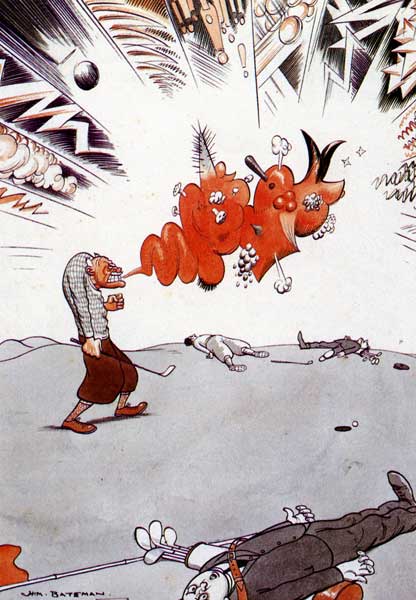Great Works: The New Word in Golf (1920s) H M Bateman
Private collection

Glenn Gould, the great pianist, had a suggestion about Modernist music. Although apparently rejected by the ears of the general public, it could be made more widely acceptable; in fact, this was happening already.
"I think that there is little doubt that there are some areas in which the vocabulary of atonality has made quite an unobjectionable contribution to contemporary life... If you really stop to listen to the music accompanying most of the grade-B horror movies that are coming out of Hollywood these days [1964], or perhaps a TV show on space travel for children, you would amazed at the amount of integration which the various idioms of atonality have undergone in these media."
A taste for squeaky door and plinky-plonk music (as the nicknames go) was being popularised through the background themes of horror and sci-fi. The highest art was being spread via the lowest genres. Gould merely regretted that, so far, the public found modern music "satisfactory only for displaying the fundamental beastliness of the human animal". But this could change.
And what about other art forms? Tate Modern has done good work, and modern visual art was never as unpopular as modern music. Still, perhaps here too low genres have helped to familiarise the difficult avant-garde. Cartoons?
H M Bateman, the cartoonist who invented the The Man Who... cartoons, was a man who had no time for modern art. He occasionally drew cartoons about it. He mocked, and his mockery was not especially bitter. Still, he might be surprised to learn how far, in one picture at least, it had got into him. (This idea develops an observation of George Melly.)
We are on the green. Our man has just missed the easiest putt in the world. The ball sits insolently on the edge of the hole. Scattered around him, knocked flat, his caddy and fellow golfers lie. Out of his mouth comes a shattering expletive, The New Word in Golf.
It goes off like a bomb. The sky radiates with its blast, in an explosive array of fanning lines of force that reverberate with zigzags and zooms. Cartoon tricks? No, they clearly show traces of modern art. These dynamic forms are borrowed from Futurism and Vorticism. Lately, advanced artists had used them to express the energy of new technology, the destruction of the Great War. Now they are on the golf course.
But despite this surrounding blast, the expletive itself is not being yelled out of an open mouth. It's being squeezed, extruded, through clenched teeth, from a face and body fully screwed up. It is literally expressed, to emerge as a raw, red-hot, pustular, intestinal, ectoplasmic blob, shuddering in the air.
What does this blob signify? It seems obvious, until you try to say. It could be an inventive form of euphemism, an expletive deleted in fact – deleted by this blob. We see a visual substitute for an unspeakable verbal obscenity that a polite publication can't print. Or it could be that the blob gives an embodiment to a curse that transcends existing language. We have to have to imagine a rage so terrible it needs a swearword that has never been used before.
A paradox: an obscenity can't be coined. A truly new swearword is impossible. You can have an unprecedented roar, but swearwords, even (or especially) the worst, must be known to have any effect; there is a list of them. And it's part of the power of this New Word that its designation baffles us. We don't know whether it stands for just a very rude word, or a horribly ugly noise, or a fury so awful it can't be given voice at all, or some kind of unknown metaphysical expletive.
Whatever, its character is clear enough. It is the essence of all wrath. It steams, it froths, it foams, it bristles, it boils and bubbles over, it's covered with verbal metaphors, all meaning anger (though what the toadstools mean is obscure). It throbs with the sores and bruises of wounded feelings. It vents with farting lips. It's impaled by a truncheon exclamation mark. But take away all those excrescences, and what have you? A curvaceous, semi-abstract form.
It seems that in this extremely expressive and mimetic shape Bateman has again drawn inspiration, and more deeply, from Modernist painting or sculpture. This form has a gross and fleshly turn, suggesting both the outsides and the insides of a body, with echoes of Miró or Arp, Surrealism generally, and even Francis Bacon. Just as the "screeching" music of Schoenberg or Webern makes a suitable soundtrack for horror and sci-fi, so the "monstrosities" of modern art have furnished this cartoon with an amazingly graphic expletive, expressing "the fundamental beastliness of the human animal" on the golf course.
But one difference from the musical examples, and an odd thing, is that Bateman's creation actually predates most of the artworks it seems to be inspired by. (Modern art: the first time as farce...) Though its year is uncertain, it must be around 1920. It anticipates pretty accurately those post-Second World War sculptures that acquired the nickname, the turd in the plaza. Take Bateman's The New Word in Golf, reduce it to its essential contours, cast it in bronze, and the resulting object would be entirely at home in the centre of a new town. You could call it simply The New Word.
Subscribe to Independent Premium to bookmark this article
Want to bookmark your favourite articles and stories to read or reference later? Start your Independent Premium subscription today.

Join our commenting forum
Join thought-provoking conversations, follow other Independent readers and see their replies